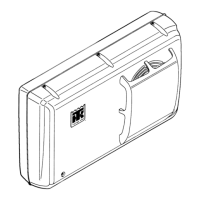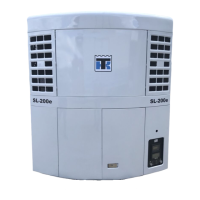Refrigeration Maintenance (Rev 1/99)
56
Testing the Refrigerant Charge with a Loaded Box
1. Install a gauge manifold.
2. Run the unit in cool on engine operation.
3. Cover the condenser to drive any excess refrigerant
from the condenser into the receiver tank.
4. As the head pressure rises, check the receiver tank sight
glass. If there is no indication of refrigerant in the
receiver tank sight glass, indicated by the float ball
being down in the bottom sight glass, the unit contains
less than a full charge and more refrigerant MUST be
added. Refer to Charging the Refrigeration System to
add refrigerant.
CHECKING COMPRESSOR OIL CHARGE
The compressors are furnished with the amount of oil
shown in the Specifications chapter. The oil level in the
compressor will change after the compressor is initially run,
making any level measurements inaccurate.
To ensure an adequate oil supply, the following procedure
must be followed whenever the refrigerant charge is lost or
removed from a unit:
1. Install a compressor on the system having a residual oil
supply and self-lubricating system such as a TK 214
model. Connect an oil separator on the discharge or
suction line to collect and drain out circulated oil.
NOTE: A suction line oil separator can be improvised
by installing a suction filter upside down in the suc-
tion line near the compressor. Cap off both access
ports, and use the lower one to drain off the accumu-
lated oil.
2. Place a normal amount of oil in the cleanup compressor
before operating.
3. Charge with 6.0 to 7.0 lb (2.7 to 3.2 kg) of refrigerant.
4. Operate at a low speed (600 to 800 rpm) for 2 hours, or
until the compressor oil level reaches a minimum
allowable level, whichever occurs first. Drain the col-
lected oil from the oil separator as it fills, taking care to
not allow any collected oil to recirculate.
5. Prepare the original compressor that was removed from
the unit (or a replacement) by draining out any existing
oil and replacing the oil with the amount of oil shown
in the Specifications chapter.
6. Install the original compressor (or its replacement), and
proceed with the manual evacuation and refrigerant
charging procedure. Charge to normal amount of refrig-
erant 5 lb (2.3 kg).
HIGH PRESSURE CUTOUT SWITCH
(HPCO)
The HPCO is located on the receiver tank. If the discharge
pressure rises above 350 psi (2413 kPa) for R-134a systems
or 470 psi (3241kPa) for R-404A systems, the HPCO de-
energizes the power relay.
NOTE: This operation is for units with printed circuit
board manufactured prior to 3-25-96 (see “P.C. Board P/N
41-776 (First Version)” on page 38).
When the HPCO opens on models using printed circuit
board manufactured between 3-26-96 and 5-21-96, see
“P.C. Board P/N 41-1619 (Second Version)” on page 39 or
after 5-21-96 (see “P.C. Board P/N 41-1812 (Third Ver-
sion)” on page 40) the HPCO will cycle the compressor
clutch only.
To test the HPCO, rework a gauge manifold per the High
Pressure Cutout Manifold illustration.

